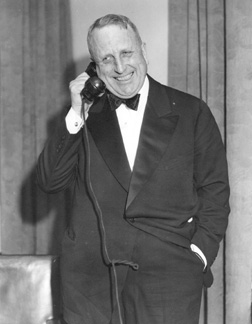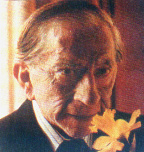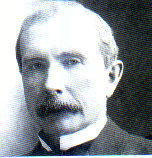

 |
 |
FAMILY FORTUNES by Kaya Morgan
 Hearst — The "Paper" Trail
Hearst — The "Paper" Trail
The Hearst publishing conglomerate, as we know it today, began with founder, multimillionaire George Hearst, who amassed a fortune in mining. Wedded to a refined, schoolteacher more than 20 years his junior, their only offspring, William Randolph was born in 1863 in San Francisco with the ultimate advantage of everything money could buy. Spoiled to the 'nth degree by his mother, he was raised with personal tutors, sent to the most elite schools and attended Harvard College until his expulsion in 1885.
Two years later, Hearst began his journalistic career by asking his father, the current owner of the San Francisco Examiner, to give him control. Father agreed, and the Daily Examiner became young Hearst's pet project, where he began developing his showmanship talent for creating maximum public shock with sensational news headline stories.
Having inherited his father's ambition but without the monetary capabilities to follow his dreams, upon George's death, mother liquidated the family mining assets to fund William's purchase of the ailing New York Morning Journal. William was almost ruthless in his quest to become the best newspaper in New York City, many times outbidding his competitors to hire the most aggressive executives and reporters even from within their own ranks. Hearst's slam-bang, outrageous editorial caught the attention of a whole new market of readers, outnumbering the competition by leaps and bounds.
Once the dust settled in San Francisco and New York, Hearst added the Chicago American in 1900, the Chicago Examiner in 1902 and the Boston American and the Los Angeles Examiner in 1904 beginning the Hearst empire that we know today. During the 1920s, one American in every four read a Hearst newspaper — consisting of 20 daily and 11 Sunday editions in 13 cities plus the King Features syndication service, the International News Service, the American Weekly (Sunday syndicated supplement), International News Reel and a collection of upscale national magazines including Cosmopolitan, Good Housekeeping and Harper's Bazaar.
Much to Hearst's dismay, his personal life continued to be a featured story in tabloids across America. Of course, his personal history gave rise to the same kind of spicy headlines that he himself utilized in his own newspapers. The women in his life were always in the limelight themselves. The day before his fortieth birthday, he married 21-year-old, Millicent Wilson, a showgirl whom he had known for many years, and finally giving up Tessie Powers, a waitress he had supported since his Harvard days. Although Hearst had five boys with Millicent, William again fell in love, this time with 20-year-old-Marion Davies of the Ziefgeld Follies. They maintained an ongoing relationship that lasted the rest of his life.
With the passing of his mother in 1919, Hearst took up permanent residence on the family's 268,000-acre San Simeon Ranch in southern California, building what is now well known as the Hearst Castle for an estimated $37 million. His personal art collection was valued at over $50 million — the largest ever assembled by any private individual.
 Getty — Gambling On Oil
Getty — Gambling On Oil
As one of the most storied families in American history, the Getty's have had more highs and lows than a soap opera, further proving that money does not buy happiness. The son of a lawyer from Minneapolis, Minnesota, Jean Paul Getty moved to Oklahoma, then to Los Angeles as father George followed the trail of oil discovery in the early 1900s.
Young Getty graduated from Polytechnic High School in 1909, then attended the University of Southern California at Los Angeles and the University of California at Berkeley while working summers as a roustabout in his father's oil fields. He received his final degree in economics and political science from Oxford University in England in 1914.
Returning to Oklahoma, Getty was determined to strike it rich as a wildcat oil man like his father. After his first successful oil well hit in 1916, he moved to Los Angeles, living the life of a wealthy playboy while at the same time buying and selling oil leases. Upon his father's death in 1930, Getty took the reins with controlling interest in the Getty Oil Company as well as nearly 200 affiliated and subsidiary firms.
An avid yachtsman, he volunteered for Naval duty at the outbreak of World War II. Although he was rejected, he took over personal management of Spartan Aircraft, a Getty subsidiary that manufactured airplane parts, eventually converting it into the highly profitable business of manufacturing mobile homes after the war.
Getty took a risky gamble by securing the oil rights to the Middle East in half of the Neutral Zone between Saudi Arabia and Kuwait. After only three years and a $30 million investment, the oil deposits discovered there made him a billionaire. As one of the richest men in the world during his lifetime, Getty became the object of both fascination and legend. The public was ever vigilant in clinging to stories of his wealth and extravagance while at the same time his scrooge-like behavior of wearing rumbled threadbare clothes, complaining constantly of requests for money ranging from immediate family members to perfect strangers.
Finally, in 1959, he established his final residence at Sutton Place, a 16th-century, 700-acre mansion just outside London. Although the immense estate had acres upon acres of gardens, pools and even its own trout stream, rumors continued to persist about Getty's penny-pinching nature when he installed a pay telephone on the manor grounds.
Married five times, his personal life took its toll with five sons, two of which died young. His grandson, J. Paul Getty III, was kidnapped while on a trip to Italy in 1973, and although was returned after a hefty ransom, had an ear cut off during the ordeal with his captives.
By far Getty's most avid interest was art. He became a serious collector in the early 1930s mainly of exquisite European furniture, paintings, sculptures and tapestries ranging from the 16th to 18th century. He viewed art as a civilizing influence on society and strongly believed in making art available to the public both for enjoyment and education.
In 1953, he founded the J. Paul Getty Museum at his ranch house in Malibu, which became his final resting place after his death at Sutton Place, England, in 1976. The original, small museum once housed a unique collection of Greek and Roman antiques, European paintings and period furniture. Today the 110-acre, stunning Getty Center and expanded museum is situated on a dramatic hilltop in North Los Angeles, and has become a well known center for permanent collections and changing exhibitions of comparative art, archaeology and cultures in America.
 Rockefeller — American's Philanthropic Giant
Rockefeller — American's Philanthropic Giant
Of all the leading American industrial families, the Rockefeller dynasty was the most remarkable. Unquestionably, there is no family in America that has contributed more both in their business ventures and philanthropic activities.
John D. Rockefeller, raised with five other siblings, moved frequently around New York State, eventually settling in Cleveland, Ohio. The son of a commodities trader who became a wandering vendor of patent medicine, his education was understandably irregular. His natural ability for mathematics prompted him to complete a course in bookkeeping at Folsom's Commercial College, which secured him a position at a large, diversified merchant firm at a starting salary of only $3.50 per week. His real reason for accepting the position was to learn as much as possible about the business world — and learn he did.
Within three years, he and friend, Maurice Clark formed their own wholesale grain and grocery business with an initial investment of only four thousand dollars. During their first year, they grossed $450,000. But, it was his deep moral beliefs that motivated and directed his life. A devout Baptist, Rockefeller was very active in the church, serving on many church boards and even teaching Sunday school. He had few pleasures, lived simply and faithfully gave away one-tenth of what he earned to charity. In 1864, he married Laura Celestia Spelman, the daughter of a wealthy businessman with whom he had four children. The family lived modestly in Cleveland until returning to New York in the 1880s.
Rockefeller foresaw the potential for gaining a monopolistic fortune in the oil business. Chaotic, with cutthroat competition, overproduction and alternating periods of boom and bust, he believed that whosoever could bring order to this wildcat industry would garner a fabulous fortune. In 1863, he and his grocery partners, along with oil refining expert Samuel Andrews built their first refinery in Cleveland and a new era was dawning. Not long thereafter, Rockefeller sold his interest in the wholesale grocery business in order to devote himself entirely to oil.
In an effort to become independent of industry related suppliers, Rockefeller proceeded to develop a series of ancillary businesses. He began making his own barrels, buying his own timber tracts, owning the warehouses, tank cars and, to every extend possible, owned or produced every raw material or transportation needed to operate the oil business. His foresight, attention to detail and lack of toleration for waste helped develop his reputation as a screwed businessman by underselling the competition, and eventually becoming the industry leader known as the Standard Oil Company of Ohio.
Rockefeller's wealth was one of the most staggering of his time. He invested heavily in the stock market and gained control of the Mesabi Range, the richest iron ore field in the United States which he eventually sold to Andrew Carnegie. He also founded the University of Chicago through an initial gift of $600,000, later donating an estimated $80,000,000 in total. He created the Rockefeller Institute for Medical Research that helped revolutionize medical education. His philanthropic activities created the Rockefeller Foundation that gave away over half a billion dollars during his lifetime. Today, those institutions continue to make social contributions that have clearly helped shape our country's history.
The family continued the legacy with John D. Rockefeller, Jr. leading the restoration of colonial Williamsburg in Virginia, building the Rockefeller Center in New York City and gifting the land for the United Nations while wife, Abby Rockefeller, founded the Museum of Modern Art. Son, Nelson Rockefeller, a Dartmouth graduate managed the family enterprises of banking, real estate and oil refining. In 1958, he took office as the governor of New York and was re-elected for three more consecutive terms. He was responsible for the most dramatic changes in New York's cultural and educational policies by increasing the state university system with 31 new campuses and helping to preserve New York's natural resources by adding 50 new state parks.

All rights reserved © 2002
Press Coverage | VentureCapital | Business Development | Venture Opportunities | Resources | Contact Us | Investor Extras | Home